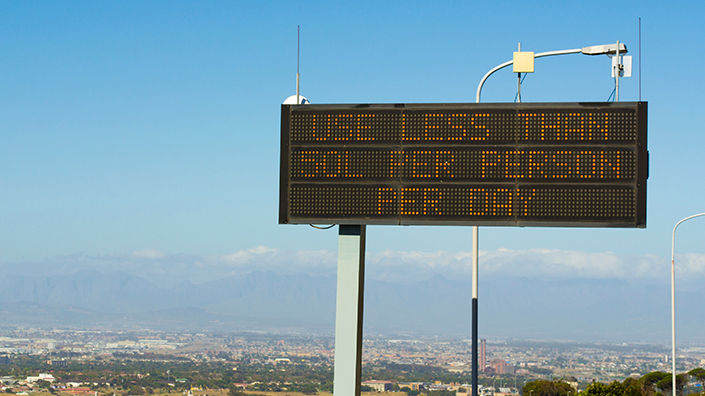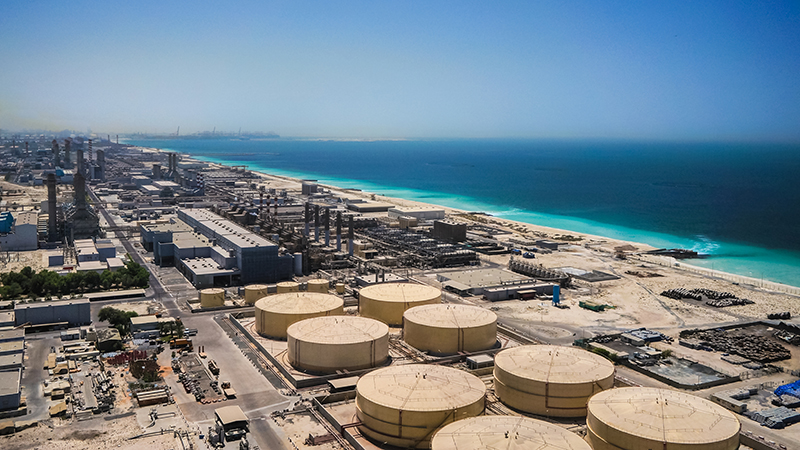In fact, none of these even makes the top 20 most water-stressed cities, according to US charity the Nature Conservancy. Tokyo tops the list, but rainy London is ranked 15th. As it stands, water use in the British capital is at capacity, and the city is set to experience shortages of supply by 2025.
Londoners are not alone. 70% of the world’s population lives in places that suffer water stress at least once a year. The European Commission defines water stress as occurring when “the demand for water exceeds the available amount during a certain period, or when poor quality restricts its use”. And, with the world’s population forecast to reach 10bn by 2050, the situation looks set to worsen.
And this is not a vision of a dystopian future, but something that is already very much happening. After a long drought, Cape Town made headlines through the first half of 2018 as it counted down to Day Zero – when the city’s six dams would run out of water. The authorities imposed strict limits on daily consumption (with 50 litres allotted per person per day) and banned the washing of cars and pavements and the watering of gardens. Eventually the clouds broke and the water behind the dams returned to higher levels, yet the experience of a major city facing such a crisis set alarm bells ringing worldwide.

(Credit: Shutterstock)
“The problem is that many of our water systems were designed for a different era,” says Richard Luthy, a professor of engineering at Stanford University in California and an authority on water management.
He explains that the ways we traditionally manage water are both environmentally damaging and wasteful. Whether it’s for direct consumption, agriculture or industry, we still depend heavily on rivers and lakes as sources of fresh water, as well as on groundwater found in aquifers. If usage is too heavy, these sources simply run dry. At the same time, we are incredibly wasteful with water we do use – most countries recycle very small quantities (the US, for instance, recycles less than 1% of its fresh water).
Only 2.5% of the world’s water is fresh, and less than 1% can be easily consumed, and so we urgently need to find new ways of managing and sourcing it. Last year, the IMechE produced recommendations for how the UK government should manage the resource in a report, Water: Drought and Flood. Alongside implementing new policies, new technologies can help tackle the problem head on.
Three-pronged action
There is no single solution to the world’s water problems, and if we are to solve this issue for future generations we will need a mix of public policy, new technologies and a change in our attitude to water. That said, one of the most important ways of dealing with the issue will be to introduce engineering solutions that take a new approach to the way we collect, store and use water.
Broadly speaking, engineers have approached this problem in three ways: improving the way we source clean water, finding brand-new ways of ‘producing’ water, and cutting the amount of water that we waste.
Shaking-up desalination
In the UK, about a third of our water comes from underground aquifers, and most of the rest comes from surface sources such as rivers, lakes and reservoirs. But, in drier countries, these water sources often cannot meet the population’s needs, leaving them dependent on unpredictable rainfall.
This has driven engineers to develop different ways of sourcing fresh water. The best known is seawater desalination, which can be done in several ways. The easiest is simply to boil salty water and distil it – thereby removing salt and leaving pure water. Another common method is reverse osmosis, by which seawater is pushed through a semi-permeable membrane at high pressure, leaving salt behind.
But both methods have limitations. To begin with, they use huge amounts of energy – one study found that thermal desalination may require as much as 60kWh of electricity to produce just one cubic metre of fresh water. Reverse-osmosis desalination must also deal with the problem of fouling – filters tend to quickly become unusable.

A desalination plant (Credit: Shutterstock)
So engineers are working on better ways of taking the salt out of seawater. A team at Penn State University in the US has developed a technique called battery electrode deionisation. It’s one of a number of electrochemical methods of desalination that have been developed in recent years, according to Professor Bruce Logan, who heads the research team. His project’s solution is uniquely low-powered.
It works by feeding salty water into a battery-like chamber, with a membrane running through the centre that only allows ions to pass through it. An electrical charge is applied to the cell and ions are drawn through the membrane, becoming attached to the electrode on one side of the chamber. This leaves the water on the other side of the membrane free of sodium chloride, meaning it can then be channelled away for consumption. But the method is presently only suitable for brackish water.
Pull water out of thin air
There’s up to 37.5 million billion gallons of water vapour in the earth’s atmosphere at any one time. What if we could tap this vast reservoir in the air around us? Canadian firm Rainmaker has developed a system that literally makes water out of air and is especially useful in the developing world. “We’re working with a government in East Africa to provide water to people who do not have access to the national water grid,” explains the company’s vice-president of business development, Rick Phillips.
Rainmaker’s air-to-water installations look a little like wind turbines and can be powered entirely by wind or solar energy. A heat exchanger is attached to the Rainmaker’s column where the air is cooled using energy produced by the turning of the turbine. When the air cools, condensation takes place and the dew droplets that form are collected in a water storage compartment.
In optimal conditions, Phillips says each unit can produce as much as 5,000 litres of water a day – which could be crucial for a rural community or refugee camp. Phillips describes some of the diverse use cases for the technology, including housing developments in South Africa that now source almost all their water from the air using Rainmakers, an entrepreneur in Bermuda who uses one to produce bottled water, and a glass factory in India whose unit provides most of its industrial water needs.
Detecting leaks
Although it’s not as eye-catching as pulling water from the air, there’s a strong argument that the main solution to our water problems is to reduce the amount we waste. In the UK, almost a quarter of fresh water put into the public supply is lost through leaks at various stages of its distribution – something like 3 billion litres a day.
Most leaks are found through periodic manual assessments of sections of the grid, which means many pipes could be losing water for months before the next inspection.
However, Swiss company Gutermann Water is attempting to change this through the use of the Internet of Things.
Sales director Steve Gilham explains how the company’s permanent installations detect leaks: “Our acoustic technology is normally attached to a hydrant or valve spindle with a magnet. During an installation, we’ll place the sensors every couple of hundred metres. They then ‘listen’ to sounds in the pipe. If there’s a break, this will cause mechanical vibrations to run down the wall in the pipe.” If changes in vibrations are detected, the sensors send this information via radio to a central logger that uploads it to a cloud-based dashboard, which water companies can use to locate the leak.
Gilham explains that very often firms can pinpoint almost exactly where the leak is in real time. In this way, an entire town or neighbourhood’s pipe network can be monitored constantly, with alerts the moment a leak occurs.
Going waterless
From washing machines to toilets, modern household conveniences use water intensively. Could they be reimagined to work without it?
The waterless toilet
A waterless toilet designed by researchers at Cranfield University recently received funding from the Bill & Melinda Gates Foundation. The Nano Membrane toilet is intended to help people in the developing world who don’t have access to clean sanitation.
The self-contained waterless toilet is designed for households of up to 10 people. Once the user has finished their business and closed the lid, the mechanism goes into action.

The Nano Membrane toilet is intended to help people without access to clean water
First, the toilet uses a rotating flush and brushes to remove all waste from the bowl. Solid waste is separated and heated with energy from a battery to dry it. Next, it is fed into a gasifier that burns the faeces and uses the heat to power the system.
Meanwhile, urine leaves the toilet bowl via a weir channel and the heat from the gasifier distils the water (which can be used around the house for cleaning or watering plants) and feeds the rest into a separate waste tank. Once a week, a technician is employed to come and clean out this tank.
Washing with less water
Washing machines also use water intensively. However, technology company Xeros says its Hydrofinity washing machine can reduce water usage by up to 80% – and it is already being used fairly widely in hotel laundries and gyms.
Once clothes have been placed in the drum, the washing machine releases millions of nylon polymer beads, as well as a spray of water and detergent. As washing commences and the temperature rises, the beads massage the clothes and microscopic cavities open up in them which absorb dirt and dust. Once the cycle is complete, most of the beads are filtered back into a separate drum and pushed to the top of the machine for use in the next wash – any remaining on clothes can simply be shaken or vacuumed off.
Xeros claims its beads can be used for up to 1,000 washes, before being recycled for reuse.
CO2 dishwasher
In 2012, students at Turkey’s Middle East Technical University filed a patent for a waterless dishwasher aimed at people living in arid areas and on-board ships.
The dishwasher works by pumping supercritical carbon dioxide (CO2 in a fluid state) into the dishwashing compartment, which spreads over all the dishes.
Then, the CO2 is turned back into a gas and this forces the grease and food particles off the dishes to a removable filter, leaving behind sterilised plates and pans.
Content published by Professional Engineering does not necessarily represent the views of the Institution of Mechanical Engineers.